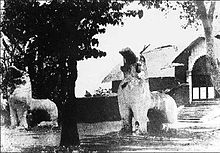
Back حرب الأنجلو-مانيبور Arabic आंग्ल-मणिपुर युद्ध Hindi Anglo-Manipur War SIMPLE اینگلو منی پور جنگ Urdu
| Anglo-Manipur War Manipur Rebellion of 1891 | |||||||
|---|---|---|---|---|---|---|---|
 The sculptures of two dragons in front of the Kangla Palace were destroyed during the war. | |||||||
| |||||||
| Belligerents | |||||||
|
| |||||||
| Commanders and leaders | |||||||
|
|
| ||||||
| Strength | |||||||
|
+395 2 mountain guns 350 riffles[3][4][5] |
+3,200 2 mountain guns[4][5] | ||||||
| Casualties and losses | |||||||
|
4 † 15 (WIA)[4][5] |
+178 † 5 | ||||||
The Anglo-Manipur War[6] or Manipuri Rebellion of 1891[7][8][9] was a short armed conflict between the British Colonial Forces and the dissenting royal princes of Manipur Kingdom, which was arguably a dependency of the British Empire in India. The conflict began with a palace coup staged by the general (Senapati) of Manipur, ousting its reigning king, and installing a half-brother, the heir-apparent, in his place. The British government took objection to the action and attempted to arrest the general. The effort failed, with the Manipuri forces attacking the British residency and the resident and other British officials getting executed. The British launched a punitive expedition that lasted from 31 March to 27 April 1891. The general and other rebels were arrested and convicted. The British annexed Manipur and governed it as a princely state till 1947.
- ^ a b c Cite error: The named reference
sPwwas invoked but never defined (see the help page). - ^ Cite error: The named reference
JiHxwas invoked but never defined (see the help page). - ^ "The London Gazette". The London Gazette (26192): 4369–4372. 14 August 1891 – via thegazette.co.uk.
As Captain Drury had only 100 rifles of the 2-4th Gurkha Regiment, 50 rifles of the 12th (Burma) Madras Infantry, and 44 mounted infantry of the 12th (Burma) Madras Infantry with him, and as I did not think this force strong: enough for the purpose, I ordered two guns of No. 2 Mountain Battery and 200 rifles of the 2-4th Gurkha Regiment, the whole under the com- mand of Captain Rundall, 2-4th Gurkha Regi- ment, to reinforce Captain Drury. Captain Rundall, on arrival at the scene of action, placed his guns on a hill about 1,000 yards from the entrenchment, and commenced to shell it.
- ^ a b c Cite error: The named reference
jxwas invoked but never defined (see the help page). - ^ a b c Cite error: The named reference
Gaziwas invoked but never defined (see the help page). - ^ Mutuwa, Miranda Bembem (2018). "Colonialism and the Princely State of Manipur: Creation of Modern Urban Space in North East India". Proceedings of the Indian History Congress. 79: 448–456. ISSN 2249-1937. JSTOR 26906278.
- ^ Majumdar, Rebellion in Manipur, 1891 (1960).
- ^ Aitchison, Treaties (1931), pp. 134–135: "While the Manipuris called the British action 'treachery' because they interfered in the internal affairs of an independent kingdom, the latter termed the events of 1891 as 'rebellion'.".
- ^ Lee-Warner, The Protected Princes of India (1894), p. 175: 'The proclamation ended thus: "The subjects of the Manipur state are enjoined to take warning by the punishments inflicted on the above-named persons found guilty of rebellion and murder".'.